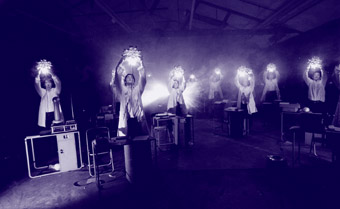IHOS: the alternating current
Sue Moss

IHOS Music Theatre Laboratory, The Tesla Project
photo Bruce Miller
IHOS Music Theatre Laboratory, The Tesla Project
Pungent kerosene lamps provide the only light source as we ascend the stairs of Hobart’s Old Net Loft, the locale for IHOS Music Theatre Laboratory’s work in progress, The Tesla Project.
The life of Nikola Tesla, son of a Serbian-Orthodox priest and an inventor-genius, provides the dramatic impetus for Constantine Koukias’ production. An ominous atmosphere is established with smoke, sand sifting through suspended white cones and a thunderstorm’s unrelenting menace: the terra familias of the Gods.
The world of Nikola Tesla’s light laboratory is evoked by Maria Kunda’s stage design. Members of the audience face each other across a narrow divide. This design device is a metaphor for the alternating current (AC) system developed by Tesla. The performers continually move to and fro along this narrow corridor transmitting the harmonic voltage of Koukias’ soundscore.
Two women sheltering beneath black umbrellas move down the long aisle. They are Tesla’s long-serving secretaries Miss and Miss (Debra Pridgeon and Sara Jones). Their highly stylised walking is emblematic of Tesla’s obsession with counting his footsteps until they were divisible by three.
IHOS Music Theatre performers rhythmically stamp their way along the central conduit. Their white shirts and black trousers embody the familiar dualism: the alternating domains of dark and light. Tesla’s AC system was in direct competition with Edison’s DC experimentation. The setting for Tesla’s secretaries and laboratory assistants is reminiscent of Kafka’s bureaucratic confinement and conformism: desks, typewriters, paper, frenetic activity and repeated sound motifs.
The largely unaccompanied singing of the IHOS chorus is as stylised as the walking of Miss and Miss. There is little room for the energetic variation of a spark, or the individual passing from voices to voice in an aural flow that enhances the suggested conductivity of Kunda’s design.
A group of children from the Helen O’Grady Children’s Drama Academy provides animated energy and transition. Representing New York broadsheet vendors they bounce basketballs, skip and cycle.
In a beautiful sequence introduced by cellist Brendon Conway, the concentration of Tesla’s team is interrupted by the illumination of electricity. Fifteen singers move through the central space each carrying a brilliant light globe. They intone electrice more and a larger globe (sculpted by Dianna Graf and Mark Cornelius), symbolising the world of light and creation, is held high. The shape resembles the Greek omphalos, a stone marking the central point of the earth. The chorus is immersed in a tiara of radiance. When the fluorescent bulbs are illuminated the laboratory team shows little exhilaration. Instead they offer a fascinated, yet contained homage.
Tesla’s AC system was used to light the 1893 World Exposition in Chicago. Dvorák’s Symphony No. 5 in E Minor (From the New World) was premiered at Carnegie Hall in the same year. The haunting second movement from New World is a recurrent refrain throughout the Tesla Project and provides a concurring coda of loss and light.
Constantine Koukias’ work is infused with the basso profundo emphasis of the Orthodox tradition. His commitment to developing bass voices in the Music Theatre Laboratory is evident in the fine tonal qualities of Russell Bailey, Matthew Dewey and Craig Wood. This connection with earth’s solidity and timbre is established in the percussive scattering of birdseed. Tesla was fond of pigeons, which here are carried in cages by a procession of children.
In the final scene Tesla’s research notes are impounded. The assistants and secretaries slowly and reverently transfer books along the central space. Excerpts from Dvorák’s melody and continual percussion accentuate their gravitas as the weight of Tesla’s genius is deposited in a locker.
IHOS has produced a powerful tribute to a brilliant and eccentric inventor. Tesla held 700 patents including a dynamo, transformer, induction motor, radio and the Tesla coil. In 1908 a massive explosion devastated Tunguska, a remote area in the Siberian wilderness. Scientists attributed the devastation to a meteorite strike. It is now speculated that a death ray developed by Tesla was responsible.
Tesla has been commissioned by the West Australian Opera. Koukias will showcase sequences as work is developed. The second sequence offered Hobart audiences the opportunity to experience an intense work in progress. Like Tesla, IHOS Music Theatre Laboratory is working to realise a vision through the interaction of energy, light and complex theatricality.
The Tesla Project, IHOS Music Theatre Laboratory, director Constantine Koukias, designer Maria Kunda, production director Werner Ihlenfeld, libretto development Marianne Fisher, music Constantine Koukias, lighting design Don Hopkins, sound operator & tape electronics Matthew Firth; Old Net Loft, Hobart, Nov 30-Dec 2.
RealTime issue #41 Feb-March 2001 pg. 33






